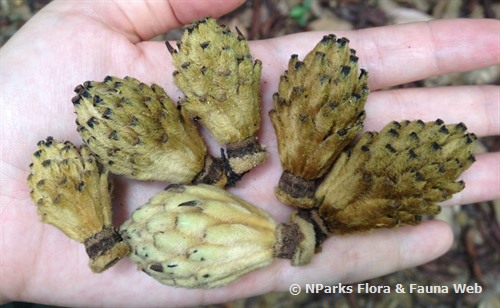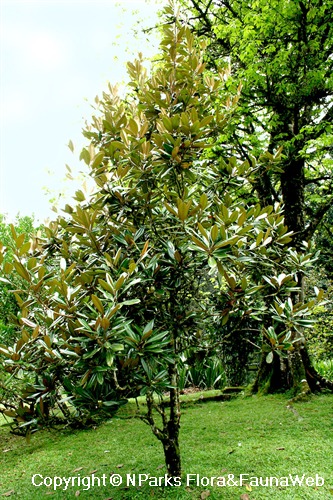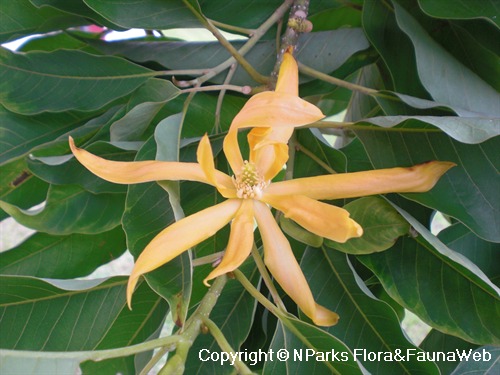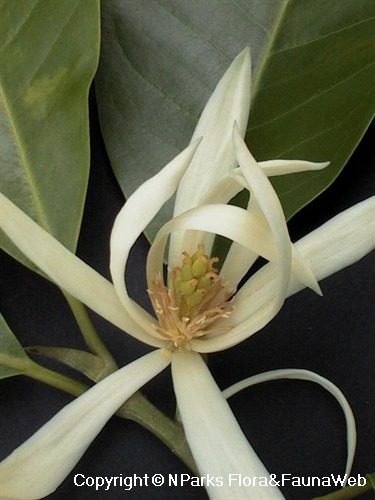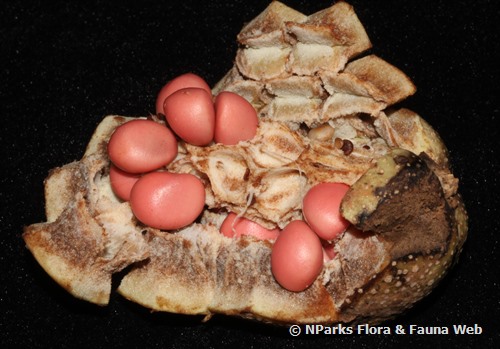
Back
Magnolia elegans (Blume) H.Keng
| Family Name: | Magnoliaceae |
| Synonyms: | Talauma elegans (Blume) Miq., Aromadendron elegans Blume |
| Common Name: | Cempaka Hutan |
Magnolia elegans or Cempaka Hutan is a large tree native to Singapore, growing to 60 m in height. It has glossy elliptic leaves with looped veins, fragrant pale coloured flowers and circular to elliptic, greyish brown fruit. The flowers can produce up to 36 tepals, with four outer tepals light yellowish green and the remaining ones white coloured. When the fruit ripens, it opens to free the seeds with pink or red thickened seed coat.
Name
Classifications and Characteristics
| Plant Division | Angiosperms (Flowering Seed Plants) (Dicotyledon) |
|---|---|
| Plant Growth Form | Tree (Big (>30m)) |
| Maximum Height | 60 m |
Biogeography
| Native Distribution | Peninsular Thailand, Sumatra, Peninsular Malaysia, Singapore and Java |
|---|---|
| Native Habitat | Terrestrial (Primary Rainforest) |
| Preferred Climate Zone | Tropical |
| Local Conservation Status | Native to Singapore (Critically Endangered (CR)) |
Description and Ethnobotany
| Growth Form | It is a medium to large sized tree with grey-coloured bark up to 60 m tall. Mostly glabrous except for the stipules where tufts of hairs are found at the tips. The inner bark is aromatic and said to resemble the scent of unripe mangoes. |
|---|---|
| Foliage | Leaves are glossy, narrowly elliptic to elliptic, 7.5–27 cm long by 3–8 cm wide. The veins joined to form loops meeting near the margin while the veinlets are densely netted, visible on both surfaces. |
| Flowers | Flowers are fragrant, up to 36 unequal tepals produced at the tips of the branches. The four, outer tepals are light yellowish-green, while the remaining ones are white. |
| Fruit | The fruit is circular to elliptic, greyish brown with white spots outside, white flesh which ripens to brown, measuring 5–7 cm long by 3–5 cm wide. When matured, the fruit opens to free the seeds with pink or red thickened seed coat, hanging by a thin elastic cord (funiculus). |
| Habitat | Occurs in primary lowland forest between 20 - 550 m in altitude. <1&2> |
| Cultivation | This species have a preference to be grown in full sun with ample space, propagated by seed. |
| Etymology | Latin Magnolia, commemorating Pierre Magnol (1638–1715), a French professor of botany; Latin elegans, elegant, the reference to which is unknown. |
Landscaping Features
| Desirable Plant Features | Fragrant (Flowers) |
|---|---|
| Landscape Uses | Parks & Gardens |
Plant Care and Propagation
| Light Preference | Full Sun |
|---|---|
| Water Preference | Moderate Water |
| Plant Growth Rate | Moderate |
| Propagation Method | Seed |
Foliar
| Foliage Retention | Evergreen |
|---|---|
| Mature Foliage Colour(s) | Green |
| Foliar Type | Simple / Unifoliate |
| Foliar Arrangement Along Stem | Spiral |
| Foliar Attachment to Stem | Petiolate |
| Foliar Shape(s) | Non-Palm Foliage (Elliptical) |
| Foliar Venation | Reticulate |
| Foliar Margin | Entire |
| Foliar Apex - Tip | Acuminate |
| Foliar Base | Attenuate, Cuneate, Rounded / Obtuse |
Floral (Angiosperm)
| Flower & Plant Sexuality | Bisexual Flowers , Bisexual Flowers |
| Flower Colour(s) | Cream / Off-White, Yellow / Golden |
|---|
| Flower Grouping | Solitary |
| Flower Location | Terminal |
| Flower Symmetry | Radial |
| Flowering Habit | Polycarpic |
Fruit, Seed and Spore
| Mature Fruit Colour(s) | Brown, Silver / Grey |
|---|---|
| Fruit Classification | Aggregate Fruit (Syncarp) |
| Fruit Type | Fleshy Fruit , Accessory / False Fruit (Pseudocarp) |
References
| References | <1> Nooteboom, H. P. (1988). Magnolia. In: Nooteboom, H.P. (eds) Flora Malesiana, ser 1, Seed Plants, vol. 10, pt. 3, pp. 557. Leiden: Rijksherbarium. <2> Nooteboom, H.P. (2012). In: Kiew, R., Chung, R.C.K., Saw, L.G. & Soepadmo, E. (eds.) Flora of Peninsular Malaysia, ser. 2, Seed Plants, vol. 3, pp. 229-230. Selangor: Forest Research Institute. Malaysia. |
|---|
Image Repository
Others
| Master ID | 29397 |
|---|---|
| Species ID | 3706 |
| Flora Disclaimer | The information in this website has been compiled from reliable sources, such as reference works on medicinal plants. It is not a substitute for medical advice or treatment and NParks does not purport to provide any medical advice. Readers should always consult his/her physician before using or consuming a plant for medicinal purposes. |


.jpg)
.jpg)
.jpg)
.jpg)
